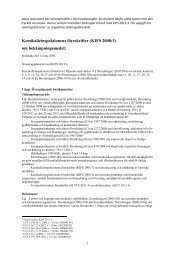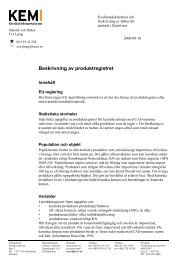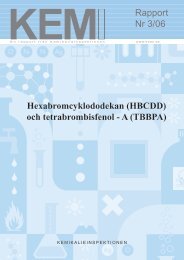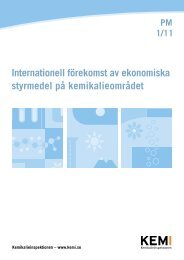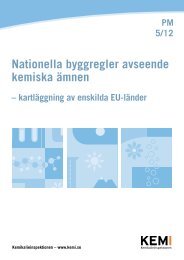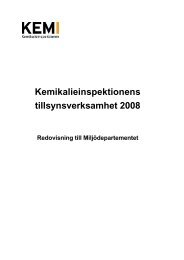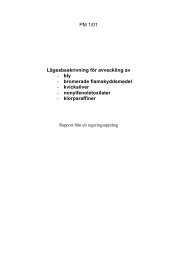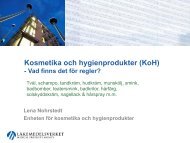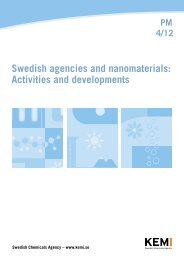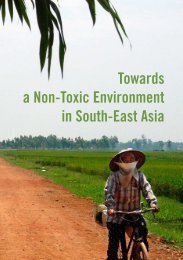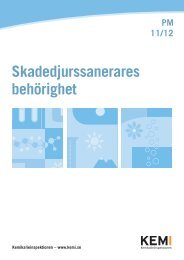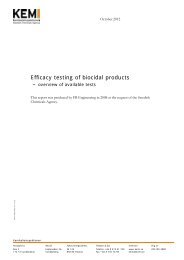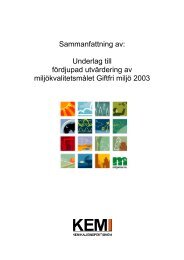Perfluorerade ämnen - användningen i Sverige
Perfluorerade ämnen - användningen i Sverige
Perfluorerade ämnen - användningen i Sverige
You also want an ePaper? Increase the reach of your titles
YUMPU automatically turns print PDFs into web optimized ePapers that Google loves.
clothes and packages). Such articles are assumed to account for the largest proportion of<br />
perfluorinated substances transported to Sweden.<br />
The largest quantities of perfluorinated substances imported to Sweden in chemical products<br />
go to the textile industry, where they are used for the treatment of sun-blocking textiles, car<br />
textiles and work clothes. It is mainly telomer based polymers that are used. Imported articles<br />
which probably contain fluorinated compounds include work clothes, sports clothes, and<br />
furniture textiles. Analyses of textiles have shown that telomer alcohols are released from<br />
clothes and other textiles. Garments treated with fluorinated compounds are rather expensive,<br />
but in return they have many desirable functions: they are water-repellent, grease-repellent,<br />
dirt-repellent and they can “breathe”. There are alternative treatments and materials which<br />
will provide some of these functions, but no non-fluorinated alternatives can at present<br />
provide all these functions.<br />
Fluorinated compounds can be used in packages for oily foodstuffs. They occur in paper<br />
product manufacturing in Sweden, but are probably more common in paper packages<br />
manufactured in central Europe, for example. It is difficult to estimate how common imported<br />
fluorinated foodstuffs packages are in Swedish shops. With regard to grease-repellent paper<br />
packages, there are alternative qualities of paper and barrier materials which function equally<br />
well in comparison with fluorinated paper. Foodstuffs packages may be assumed to constitute<br />
one source of direct exposure for humans, since fluorotelomers have been shown to migrate<br />
from packages into foodstuffs.<br />
Fluorotelomers are used in fire fighting foam for their film forming properties and the ability<br />
to decrease fuel absorption. These foams are especially useful for major fires, e.g. chemical<br />
fires. The quantities in the foam are low, less than one per cent, but the foam is directly<br />
released into the environment. The largest use of fire fighting foam is in fire exercises, and<br />
then the foam used is no longer considered to be reliable for extinguishing fires. According to<br />
information received, the amount of foam past its use-by date which is destroyed is relatively<br />
small. This is probably true also of foam containing PFOS which still exists in public stocks.<br />
There are fluorine-free foams available today, but they are not as effective. However, research<br />
is being carried out, which in the long-term may provide effective fluorine free alternatives.<br />
Fluorinated tensides are used in very low levels in a large number of cleaning products, e.g.<br />
polish, waxes, all-purpose cleaners, window cleaners etc. Their use is widespread and directly<br />
released into wastewater. The use of fluorinated tensides in products with cleaning functions<br />
does not comply with the EU Regulation (EC no. 648/2004) on detergents since they are not<br />
sufficiently biodegradable. In products such as polish, fluorinated compounds are not added<br />
primarily for their cleaning characteristics but because they provide good spreading properties<br />
and an even surface. According to information, there are no good alternatives to<br />
perfluorinated substances in polish, but silicones are seen as having potential for<br />
development.<br />
In some countries measures have been taken to decrease the risks associated with<br />
perfluorinated substances. Canada has prohibited four telomer based compounds and is<br />
expected to continue work in decreasing risks associated with similar compounds. USA’s<br />
environmental authority has acceded to a global voluntary agreement with a number of<br />
companies that have undertaken to drastically reduce emissions from production plants and<br />
levels of PFCA related compounds in their products.<br />
8



